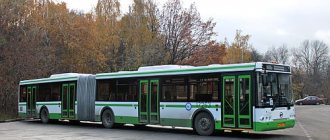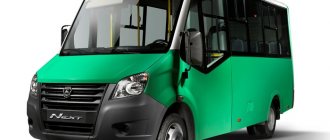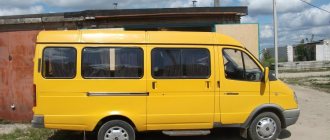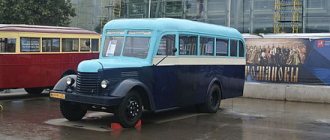Low-floor buses in Russia
K. Ushanov, photo by the author
The lower the better. Within a reasonable
The first low-floor bus that passed through the testing department of RIA "Rossbusiness", which publishes the magazines "Fixed Means" and "Truck Press", were vehicles of the bus branch of the Minsk Automobile Plant (AMAZ), and immediately the low-floor 15-meter three-axle MAZ-107 (6x2). It must be said that in 2001, when the first model of the MAZ-107 was born, it was a completely crude version. The bus was equipped with a weak Renault engine and a non-steering rear axle.
Fully loaded, he walked with tension on a slight rise and wore down the rear axle tires to “slicks”. In 2003, we tested another sample of the Minsk three-axle MAZ-107-060 at the FSUE NITSIAMT test site and fully felt the difference between the first sample and the current model.
The Minsk bus now has a rotating rear axle of its own design, and the 280-horsepower Mercedes-Benz OM906LA diesel engine, which complies with the Euro 3 standard, gives the bus excellent dynamics even at full weight. The power unit is coupled with an automatic transmission from Voith.
The capacity of the MAZ-107-060 is 150...160 passengers, seating capacity is 25...31, depending on the interior configuration. This capacity is obtained due to the so-called “mine” layout of the engine compartment, i.e. on the left in the rear of the bus. The power unit is also located on the base model MAZ-103. In 2003, the MAZ-103-065 version with disc brakes and a ramp for wheelchair access was introduced in Russia.
On the articulated low-floor bus MAZ-105, the power unit is located centrally, in the main compartment of the cabin. The maximum capacity of this bus is 190 people.
| MAZ-107 on the route in Minsk |
The standard equipment of all models of Minsk low-floor buses includes ABS and ASR systems, air suspension, a floor level regulator that corrects the level of its inclination at stops, and a differential locking mechanism. Almost all communications, except electrical wiring, are located in the upper part of the bus interior in niches, very similar to luggage compartments in intercity and tourist buses. The body frames are protected with an anti-corrosion compound, the external cladding of the body is made of galvanized sheets, the wheel arches are made of stainless steel.
At the buyer's request, Minsk buses are equipped with turbocharged diesel engines: V-shaped six-cylinder YaMZ-236 HE (MAZ-104), Renault, Mercedes-Benz, Deutz, MAN or in-line six-cylinder MMZ D-260.5. All engines comply with Euro 2 or Euro 3 environmental standards.
Low-floor AMAZ buses have spacious door openings, large storage areas, and good ergonomics for both passengers and the driver. The buses are very maneuverable and easy to drive, which is of great importance on city routes. If at a bus stop there is a car standing too close, say, at a distance of 1...1.5 m from a stopped bus (which is prohibited by traffic rules), then the bus will calmly go around this obstacle. A great advantage in maneuvering in city traffic, especially on the crowded streets of Moscow and St. Petersburg, is provided by the good acceleration dynamics of all AMAZ models.
| The MAZ-107 has a low floor along the entire length of the bus |
In Moscow, mainly MAZ-103 buses operate on routes, and even then in small numbers. But in Yaroslavl, St. Petersburg, Kemerovo and others, on urban and suburban routes you will more often see buses made in Minsk.
AMAZ supplies its products to Romania, Hungary, the Baltic countries, and former Soviet republics. Recently, operators from Germany have become interested in Minsk buses, which indicates a high level of production of Belarusian vehicles, since Germany itself produces some of the best buses in the world.
Swedish Russians
On June 18, 2002, the official opening of the bus and the release of the first city bus Scania Omni Link CL94UB 4x2 took place in St. Petersburg. Scania-Peter LLC is a Russian company with 100% Swedish capital. It is integrated into the overall production system and fully complies with all Scania requirements, as well as European and Russian legislative requirements for product quality.
The design of the Scania Omni Link CL94UB 4x2 base is combined. The front and middle parts are low-floor, the floor on the front door area is heated. The design of the rear part, where the power unit is located, is frame, made of open profiles. Accordingly, the entrance to the rear third door has steps.
| The original location of the power unit on the MAZ-103 and MAZ-107 buses is shaft on the left side |
The body of a Swedish coach-type bus, assembled in Russia, is framed from longitudinal-transverse aluminum beams. The originality of the body is that its frame is entirely assembled from aluminum profiles without the use of welding. The front and rear panels (“masks”) made of multilayer fiberglass are also installed without welding, using special glue. In general, this ensures high corrosion resistance, reliability, durability of the bus and guarantees its service life of at least 20 years.
The side and rear windows are tinted double glass without shatterproof gas-filled glass, glued into the body. Panoramic windshield - monolithic tinted triplex. The bus uses the most modern noise and vibration damping materials.
The St. Petersburg Scania Omni Link ventilation and heating system is interesting, which, combined with good thermal insulation of the bus, provides a comfortable microclimate in the cabin. The design of the bus includes in the heating system, in addition to convector heaters on the side walls, ceiling heaters that supply heated fresh air through air filters into the cabin. As a result, the bus windows do not fog up or freeze even in severe frost.
The driver's workplace is perfectly designed: the air-suspended seat is adjustable both horizontally and in terms of backrest angle. The steering column is also adjustable. Visibility from the driver's seat is excellent, and handling is worthy of praise. The bus has comfortable acceleration: the gas pedal responds to the slightest command from the driver, and acceleration occurs very smoothly, but quickly.
| Scania city buses in the St. Petersburg park |
Good traction dynamics of the Scania Omni Link are provided by the Scania DC 901 (Euro 3) diesel engine, located in the rear overhang. Its working volume is 9 liters, power – 230 hp. Quite acceptable for working on city streets. The engine is mated to a ZF 5HP 502 C automatic transmission (five forward gears), a locking device to reduce fuel consumption and an integrated hydraulic retarder. The power unit also has a “zest”. The gearbox is coordinated with Scania's electronic fuel injection system, which ensures smooth gear changes, powerful and smooth retarder functions and reduced fuel consumption.
The driver controls the air suspension from the workplace, increasing ground clearance and overhang angles when passing obstacles.
Scania Omni Link is designed to work with long service intervals: 20 thousand km in urban conditions and 35 thousand km in suburban operation. In general, the resource of the power unit is designed for 2 million kilometers. The most important advantage of Scania Omni Link buses is reliability and, accordingly, profitability. The customers of Scania-Piter LLC are municipal and private transport enterprises in cities such as St. Petersburg and the Leningrad region, Moscow, Samara, Kurgan, Neryungri (Yakutia), Astana (Republic of Kazakhstan), etc.
Low poly from the Moscow region
| Scania low floor with heating |
Based on the description of previous low-floor buses, one might get the impression that no company in Russia produces vehicles of this type. And this will be half fair. Indeed, in the Russian Federation not a single bus plant produces low-floor buses in-line. However, it cannot be said that Russian bus manufacturers are not working on this topic at all.
At the Moscow bus plant in Likino, they developed a new model of a city bus with a low floor - LiAZ-5292. This model has undergone serious restyling, but the familiar features of the LiAZ-5256 bus are very well recognizable. The layout of the bus is new - four-stroke six-cylinder in-line diesel Caterpillar 3116 (Euro 3) with a power of 230 hp. aggregated with a Voith automatic transmission, located transversely at the rear and connected to the drive axle using a bevel gear. Thanks to this, the power unit takes up little space in length, which, combined with the use of the original RABA rear axle, made it possible to create a low floor along the entire length in the cabin. The Likinsky car is equipped with disc brakes on all four wheels with ABS brakes as standard. Access to the engine compartment is possible both from the rear, through the opening rear wall, and from the interior, where there are two removable panels.
The interior of this model is designed for 120 passengers, with 22 seats. The interior of the city car makes a very pleasant impression: it is beautifully decorated, and the low floor adds comfort to the interior.
| Workplace of the Swedish-Russian bus driver |
The driver's workplace is equipped with an air-suspended seat with a sufficient number of adjustments to comfortably accommodate a person of almost any size. The steering column is adjustable, and the selected position is fixed by a push-button pneumatic locking mechanism. It should be noted that an adjustable steering column was used for the first time on the vehicles of Likinsky Bus LLC. The steering wheel is very comfortable: it is made in such a way that the instrument cluster is perfectly visible from the driver’s seat at any position of the steering column.
The Likinsky bus moves smoothly, swaying slightly on uneven roads. The automatic transmission does not falter or jerk when accelerating. Acceleration dynamics, as well as braking efficiency, are not bad. When maneuvering the steering wheel does not require much effort. In addition, there is a slight self-return of the steering wheel, and this is generally rare on buses.
When measuring the maximum speed, the Likino bus accelerated to 81.6 km/h and stopped accelerating, since the Caterpillar engine is equipped with an electronic speed limiter. But the city LiAZ-5292 doesn’t need more. Its fuel consumption in simulating city traffic mode with a full load is only 32.3 l/100 km, which is a very good indicator for such a car.
Let us remind you once again that LiAZ-5292 is a prototype of Likinsky Bus LLC, and if all minor shortcomings are eliminated by the start of mass production, passengers of low-floor cars of the Moscow region plant are guaranteed a pleasant trip.
Excellent review
“It looks unusual from the outside - an aquarium on wheels. But it’s very comfortable inside – almost like being in a big bus.” Maria, passenger.
Small class bus "Gazelle CITY" -
a unique offer on the market. There are simply no other serial low-floor cars of this size with panoramic glazing on the market. The bus carries 22 passengers and is only 6.6 meters long. It is nimble and maneuverable - a godsend for a metropolis with its narrow streets or huge traffic jams. The economical diesel engine consumes only 12.5 liters of fuel per 100 km. The bus warranty is three years without mileage limitation.
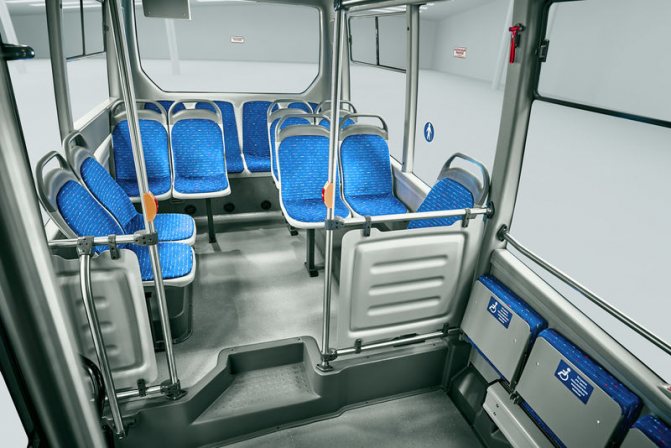
But the main advantage of Gazelle CITY is the convenience of passengers. The low floor (25–32 cm) allows you to enter the salon in one step. The width of the automatic door - 110 cm - allows you to easily roll a baby stroller or wheelchair along the folding ramp. The seat is provided with a special place in the cabin, equipped with a fixation system. The adjustable air suspension gives the bus a smooth ride, and huge panoramic windows provide excellent visibility. A spacious storage area, stainless handrails, comfortable and practical passenger seats - this compact bus will provide passengers, including people with disabilities, the highest level of comfort.
It’s also convenient for the driver. His workplace is separated from the salon by a partition. The heated seat with lumbar support has five degrees of adjustment, and the steering column is also adjustable. The rear view mirrors are electrically adjustable.
